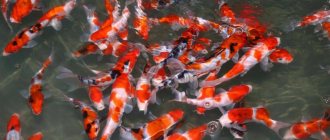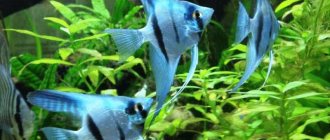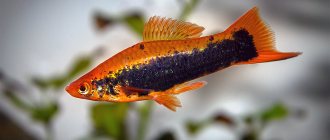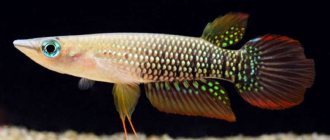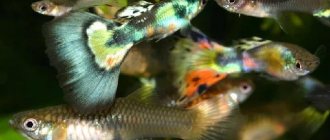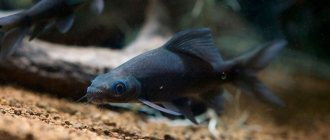Description of the fish
Red cichlid fish - this name was given to the fish by its bright, memorable appearance. In Latin, her name sounds like Hemichromis bimaculatus. Amateur aquarists admiringly call the African fish the pearl, pearl cichlid, blue or green pearl.
There are also names such as chromis red, hemichromis.
Appearance
Chromis red is a dazzling purple color; there may be varieties with an orange body color.
Handsome Chromis is a medium-sized cichlid whose body is colored red.
Starting from the head and ending with the tail, as well as on each fin, green-blue inclusions are scattered. They shimmer even in low light. These overflows play especially beautifully during the spawning period. There are black spots on the sides and behind the gills.
Aquarium chromis is quite large in size - about 15 cm. The fins on the back and at the bottom of the tail are pointed. The tail is rounded.
Habitat
Hemichromis bimaculatus has chosen the Nile, Congo, and Niger basins in Central and Western Africa, starting from Southern Guinea and ending with central Liberia. He chooses ponds densely overgrown with aquatic plants, in which the water flows very slowly. Prefers the middle and bottom layers of rivers.
Features of behavior
The predator hemichromis is unusually hardy and easily adapts to various living conditions.
The character traits of the beautiful Chromis aquarium fish include aggressiveness and unpredictability. More often they appear when fish are spawning and caring for their offspring.
Chromis is equally aggressive towards its relatives and other fish species.
Handsome Chromis does not tolerate invasion of his territory
Lifespan
Chromis live in an aquarium for 4-5 years, if the conditions of detention are observed.
General information
Coils (Planorbidae) are a family of freshwater gastropods, widespread on almost all continents. Some species are frequent inhabitants of home aquariums, getting here mainly by chance (spawn or young snails are usually carried on plants). Although some aquarists keep them purposefully for the sake of variety or as food for certain types of fish.
Coils are unusually hardy mollusks, can exist in various water conditions, and reproduce easily and quickly. These invertebrates can breathe in two ways - using oxygen dissolved in water and atmospheric air.
The coils can breathe both oxygen dissolved in water and atmospheric oxygen.
An interesting feature of the reels is the ability to move along the surface of the water with the shell down. The snails are helped to maintain balance by the air they draw into their shells when breathing. The support is the surface tension of water or a bacterial film. True, if you even slightly touch the snail at this time, it will immediately begin to sink. This allows them to escape from predators.
Coils are capable of multiplying very quickly, but this happens mainly in conditions of excess food, when the aquarist regularly overfeeds the fish.
The positive aspect of keeping coils is that these mollusks do not spoil plants, but they process dead leaves with a bang, being typical detritivores.
It is not recommended to bring coils from natural bodies of water into the aquarium. Gastropods are intermediate hosts of many types of parasites that are dangerous to fish.
Types of handsome chromis
Ichthyologists distinguish three main species.
- A real handsome chromis. This species was the first to be described (hence the name). He has no spots near his tail.
- Two-spotted. There are two distinct dark spots on the body of the fish.
- Tall. This species is characterized by a taller body and fins. And the spots are less pronounced.
Really handsome Chromis
Two-spotted Chromis
Tall Chromis
In recent years, two more species have been developed:
- Neon Chromis. Already managed to gain high popularity. Their iridescent spots are large and connected in an intricate pattern. There are no spots on the sides.
- The red chromis beauty is a hybrid variety. It received its name and wide recognition due to its very bright color.
All types of chromis are kept in aquariums.
Two-spotted
In Latin - Chromis elerae. It is found in the coastal areas of the rivers of New Guinea and Central Liberia. The body length reaches 12 cm. The color is brownish-olive or red-beige, with the female being brighter than the male.
There are dark spots in the middle part of the body and on the gill cover. The back is usually darker, on the side it acquires a greenish tint, and the belly is already reddish.
Keeping in an aquarium
Special care for the handsome chromis cichlid is not required. A suitable aquarium has a minimum volume of 50 liters and a maximum of 120 liters. It is better to take a rectangular aquarium rather than a round one (in order to save space in the room). The size of the container will depend on the number of fish.
For two chromis, it is still better to use an aquarium of the maximum size.
You can keep two pairs of hemichromis in one aquarium, but the space in it will need to be well divided. A large snag that will divide the territory into two sections is very suitable for this. Shelters of various shapes and types (stones, grottoes, small snags) can be used to prevent territorial conflicts among these fish.
How and what to feed red cichlids
Representatives of this species are very gluttonous and greedy for food. They can absorb huge amounts of food without experiencing hunger, and along the way feast on small animals, including more compact “neighbors” and vegetation. It is especially difficult for the fry - it is almost impossible for them to hide from these predators.
Such an appetite can seriously worsen the health of gluttons: when they overeat, their digestion is disrupted and various diseases develop. It is important for owners not to overfeed their pets and to properly balance their diet:
- the menu must include sources of animal proteins - these can be pieces of beef or minced meat, they can also be fed with pieces of fish;
- You should not neglect frozen or live food - you can feed tubifex worms and crushed earthworms;
- The diet should include vegetables containing vitamins, microelements and other useful components. Residents are treated to slices of fresh cucumbers, zucchini, chopped spinach leaves, and lettuce;
- It is important to note that plant foods should not be the basis of the diet for these fish; they are “meat eaters”.
Modern aquarists often prefer ready-made, multi-ingredient foods that are intended specifically for cichlids. And this is a great solution. This well-balanced food, containing everything necessary, is suitable for aquarium pets.
Today there are aquarists who take it upon themselves to create menus for their pets. Usually the preferences and tastes of the wards are taken into account. Beautiful chromis are fed once a day, less often - twice. The dosage of the finished diet is indicated on the packaging. If you create your own menu, the amount of food will have to be determined experimentally.
Compatibility
The compatibility of handsome chromis is very low. Only other large cichlids, the chain catfish and the huge barb, can survive next to them. Goldfish and angelfish, although large, but slow-swimming, risk their lives next to the handsome man. Chromis does not get along well with snails, not to mention shrimps and crayfish during the molting period. Amphibians such as axolotls or frogs can also be killed by chromis.
To reconcile chromis with other fish, it is necessary to delimit the aquarium bottom, using driftwood and stones for this purpose.
Compatibility table for handsome chromis
Reproduction
Breeding beautiful chromis is not a difficult matter, if you take into account some of the characteristics of pets. The fish reach sexual maturity by 6 months, subject to optimal maintenance and feeding. During this time they grow up to 7 cm.
Monogamous chromis always spawn with the same partner. But it is precisely the creation of a pair for reproduction that is very problematic due to the handsome man’s intolerance towards any neighbors. Male cichlids fight with any fish that invade the territory they occupy, even with females. Often, before the chromis find a suitable mate, more than one fish manages to die.
If the fish have already chosen their mate, then they will spawn only with her for the rest of their lives.
Sex differences
In all species of cichlids, it is difficult to distinguish males from females. Many people believe that the male looks more massive than the female of the same age. But this sign is not always correct.
It is very difficult to distinguish a handsome male chromis from a female.
The most reliable indicator of sex is the shape of the anal and dorsal fin. In males, their ends are more pointed.
This sign is true if you distinguish between beautiful fish of the same species. But this no longer works with different species. An increase in bright color during spawning will also not be an accurate sign of distinguishing males from females in different species. To distinguish offspring from the same spawning, you can safely use the indicated characteristics.
Pair formation
Due to the aggressiveness of cichlids, it is recommended that future breeders of offspring be introduced to each other gradually. For this purpose, a glass partition is placed in the aquarium where the fish will spawn. The male and female are placed on opposite sides of the partition.
If the individuals are friendly with each other, then the glass can be removed already on the second day . At the first sign of aggression, the female should be quickly removed. She is weaker than the male and is more likely to die.
Using the same method, you can try to create a pair with another fish as many times as necessary. When there is no hostility, the couple unites once and for all.
A pair of chromis is created forever, as many cichlids are monogamous
After two cichlids find each other, preparations for spawning begin. It is then that the partners, especially the male, show themselves in amazingly bright colors.
Preparing for spawning
To stimulate fish spawning, the temperature of the aquarium water should be increased to +28 °C (+27–29 °C). Large flat stones should be placed at the bottom. This is where the female will spawn.
The stones are cleaned through the joint efforts of the couple. The male builds shelters in the ground for the fry (furrows and holes).
Spawning
The fertility of the handsome chromis is very high: during the spawning period, the female is capable of laying about 500 eggs.
Caviar is deposited on clean, smooth surfaces. Rarely does this happen inside a potted plant. As a rule, parents together protect the clutch, attacking everyone approaching, even large fish.
Larvae and fry
After just a couple of days, the larvae emerge from the eggs. The female needs to hide them better. She chooses one of the shelters built by the male. The next day, the female will hide the offspring in another place.
The cichlids take care of the fry together until they begin to swim and feed on their own. This happens quickly - on their third birthday.
Chromis fry begin to swim on the third day after their appearance.
After 10 days, when the fry grow about 1 cm in length, they need to be transplanted. At this time, adults are preparing for a new spawning.
Parents no longer care for the fry and begin to perceive them as prey. Cannibalism is also observed among juveniles, so they must be sorted periodically.
The food of Chromis fry should consist of Artemia larvae (Artemia nauplii).
Breeding
One of the most exciting and long-awaited moments for every aquarist is the creation of a pair of fish and the breeding of offspring, especially if you have a handsome chromis. Reproduction begins with the individuals changing color, the female becomes crimson-red, and the male’s blue-green spots begin to shine.
The first time fish produce offspring is at the age of approximately 9 months.
The pair chooses a place for spawning, driving away all guests from it. The nursery usually becomes a flat stone, the walls of an aquarium, or a model of a sunken ship. Having laid eggs, the parents take turns guarding them, using the movements of their fins to ensure the flow of water.
One clutch contains from 300 to 500 eggs. Development proceeds quickly, and after 4 days the fry will hatch. The babies remain in place for another week, during which time they will finally develop and begin to try themselves in independent swimming. Parents continue to accompany their offspring here too.
Another 10 days will pass, and the fry will reach a length of approximately 1 centimeter. Now it is already possible to separate children from their parents, placing them in a nursery aquarium, where in six months adult chromis will swim. Reproduction, as you can see, does not pose any particular difficulties.
Chromis diseases
Handsome chromis have a fairly strong immune system and good disease resistance.
They can get sick mainly due to mistakes in organizing the conditions of detention. They are mainly committed by beginners: they incorrectly filter the water and aerate it. Due to these unfavorable factors, poisons accumulate in the aquarium, which destroy all living things, or fungi of the columnaris type. The pet's immunity drops and illness occurs.
The fish can also get sick due to using a container of the wrong size.
A small aquarium can cause fish diseases
For prevention, it is advisable to maintain appropriate water parameters, follow a feeding regime, and monitor the cleanliness of cleaning equipment. If you form a pair of new fish, they must first be quarantined.
If the fish are sick, you can tell by the following symptoms:
- the gills are everted, the mouth is open;
- the color of the skin becomes cloudy;
- scales stick out or fall out;
- the fish eats poorly and moves sluggishly;
- eyes are cloudy, with whitish flakes.
If any of the above symptoms or deviations in the behavior of the fish are noticed, it is recommended to carefully add a little hot water to the aquarium - bring the water temperature in it to 31 degrees - or add a little ordinary salt to the water (about 5 g of salt per 1 liter of water) .
If this does not help, you should contact an ichthyopathologist.
Content Tips
Caring for beautiful chromis is quite simple. The composition of the water does not play a big role for them. It is important to create a sufficient number of shelters for the beauties, because if there are several fish, deaths are inevitable.
Cichlids need plenty of hiding places to prevent them from fighting among themselves.
Warm water (+24–26 °C) is most favorable for keeping chromis. Not allowed above +31°C and below +18°C. The higher specified temperature is necessary for fish only during the spawning period.
Pearls do not like too clean water, which makes them easier to care for. There is no need to completely change the water in the aquarium, but only periodically replace a quarter of it.
Other tips:
- Since cichlids actively dig in the aquarium, it would be a good idea to purchase a powerful external filter.
- To provide the fish and beneficial bacteria that live in the aquarium with oxygen, it is advisable to purchase a compressor.
- Place glass on the aquarium. In this case, warm water will evaporate more slowly, and fish, carried away by hunting or chasing, will not be able to accidentally jump out.
- It is not possible to create a pair of hemichromis that is capable of spawning in an aquarium with a volume of up to 100 liters.
An aquarium compressor is used to enrich water with oxygen.
The offspring must be divided into groups according to size, otherwise many fry may die. Only the largest and strongest individual will remain.
Interesting Facts
- European aquarists have been breeding hemichromis for more than a hundred years, but these attractive aquarium inhabitants are still not becoming less popular.
- Cichlids are highly adaptive: keeping them in hard water is just as acceptable as keeping them in soft water. Hemichromis easily take root in very turbid water that contains a high concentration of oxygen.
- Hemichromis are prone to strict territorial ownership; if they tolerate anyone, it is only the partner they have chosen. A couple is chosen once and for life.
- These fish are so prolific that the German ichthyologist Günter Sterba gave them the name “generators of new fish.”
Reviews
Owners of red cichlids complain about the fish’s aggression and pay attention to the choice of aquarium inhabitants. Plants are severely destroyed and artificial ones are used.


